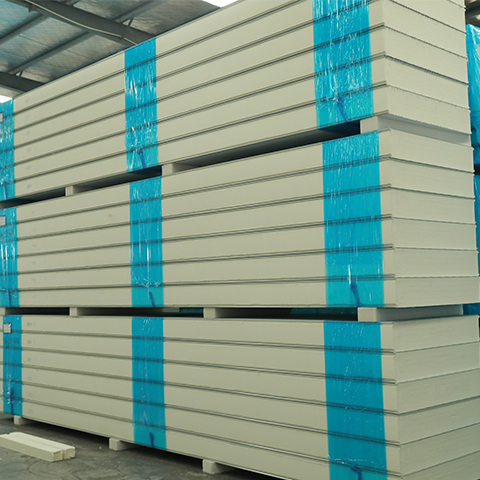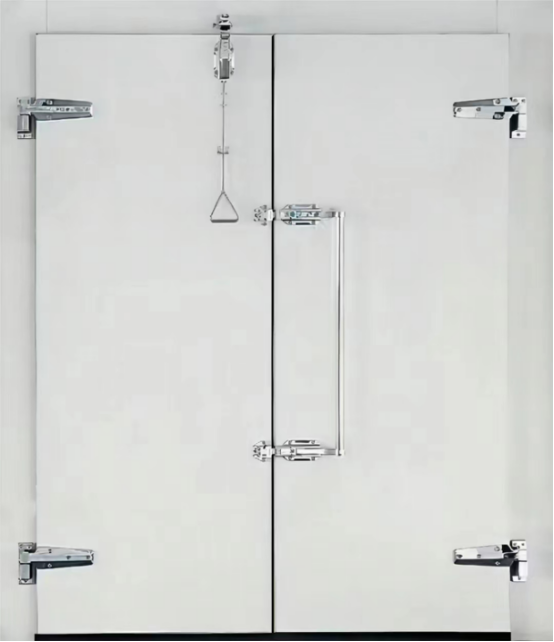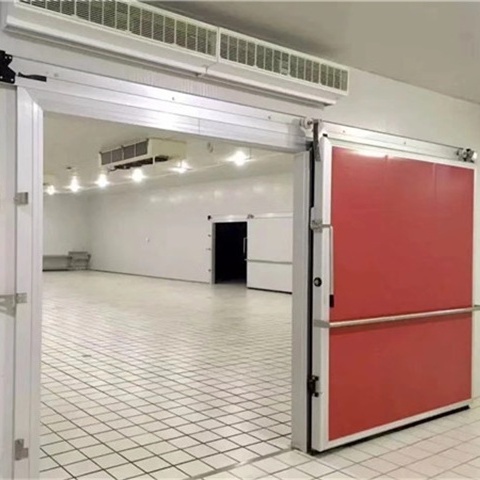Cold storage is a crucial facility for storing food, medicine, and other supplies. Maintaining a stable internal environment is directly related to the quality and safety of stored goods. During cold storage operation, attentive users will notice that exhaust fans often operate intermittently rather than continuously. This seemingly "discontinuous" operation mode is actually an optimal solution based on multiple considerations, including thermodynamic principles, energy conservation requirements, equipment protection, and precise environmental control. This article will deeply analyze the underlying logic behind intermittent activation of cold storage exhaust fans from three perspectives: technical principles, practical applications, and optimization strategies.
A. Core Functions and Working Scenario Positioning of Cold Storage Exhaust Fans
(I) The Multiple Roles of Exhaust Fans in Cold Storage Systems
Cold storage exhaust fans are not single-function devices. They fulfill four core tasks within the refrigeration system: heat exchange, humidity regulation, air circulation, and removal of harmful gases.
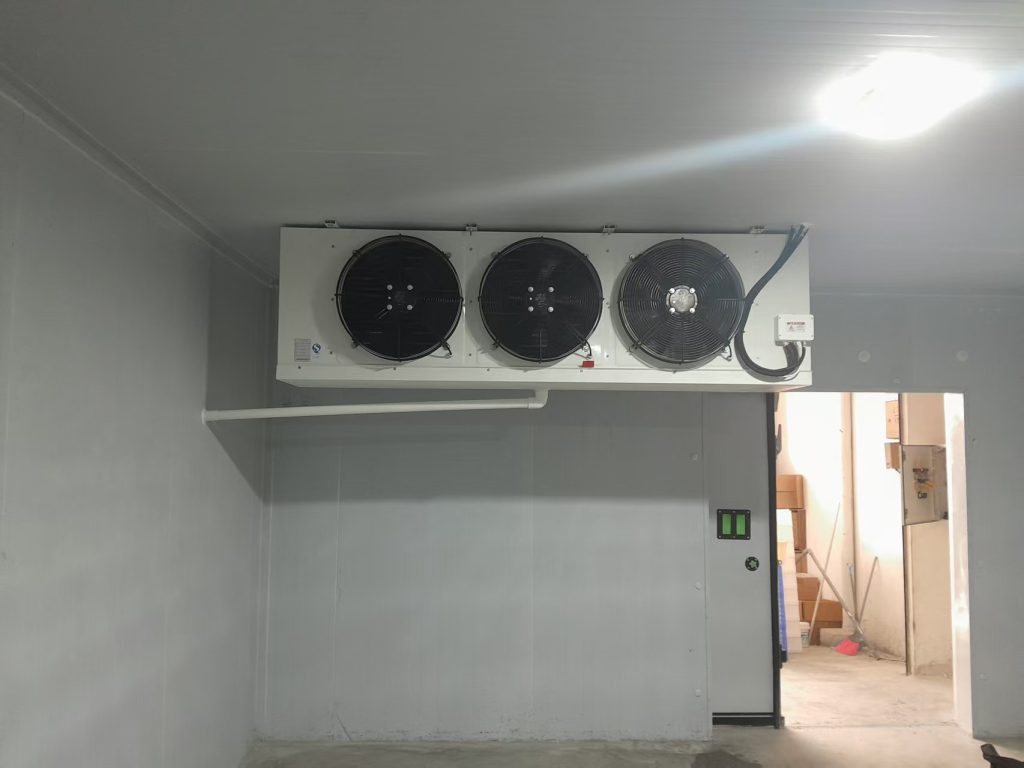
- Heat Exchange: When a cold storage facility is in operation, the refrigeration unit itself generates heat, and the respiration of the goods also releases energy. Exhaust fans must promptly remove this excess heat to prevent temperature fluctuations within the warehouse.
- Humidity Control: The transpiration of stored items (such as fruits and vegetables) increases humidity within the warehouse. Excessive humidity can easily lead to mold growth. Exhaust fans assist dehumidification equipment by circulating air.
- Air Circulation: Ensures a uniform temperature distribution within the warehouse to avoid hot or cold spots that could affect the quality of stored goods.
- Harmful Gas Removal: Exhaust fans replace gases like ethylene and CO₂ produced by the respiration of fruits and vegetables with fresh air to prevent spoilage.
(II) Differences in Exhaust Fan Functionality Between Different Types of Cold Storage
Based on storage temperature and cargo type, cold storage can be divided into refrigerated storage (0-10°C), frozen storage (below -18°C), and ultra-low temperature storage (below -30°C). The operating logic of these exhaust fans differs significantly:
| Cold Storage Type | Core control objectives | Exhaust fan start trigger conditions | Run time ratio |
| Cold Storage | Humidity + Gas Composition Control | Humidity > 85% or CO₂ concentration > 1000ppm | 30%-50% |
| Freezer | Temperature stability | Dehumidification after the storage temperature exceeds the set value + 0.5℃ or defrosting is completed | 10%-20% |
| Ultra-low temperature storage | Reduce cooling loss | Starts only after the door is opened or when the device temperature rises abnormally | <5% |
- Table: Comparison of operating characteristics of different types of cold storage exhaust fans
(III) Synergy between Exhaust Fans and the Refrigeration System
Exhaust fans do not operate independently; instead, they form a closed-loop control system with the refrigeration compressor, evaporator, condenser, and other equipment. For example, in a typical cold storage facility, when the temperature rises, the thermostat first activates the compressor to cool the room. If the temperature rise is accompanied by an increase in humidity, the exhaust fans and compressor activate in tandem. This synergistic mechanism ensures maximum energy efficiency.
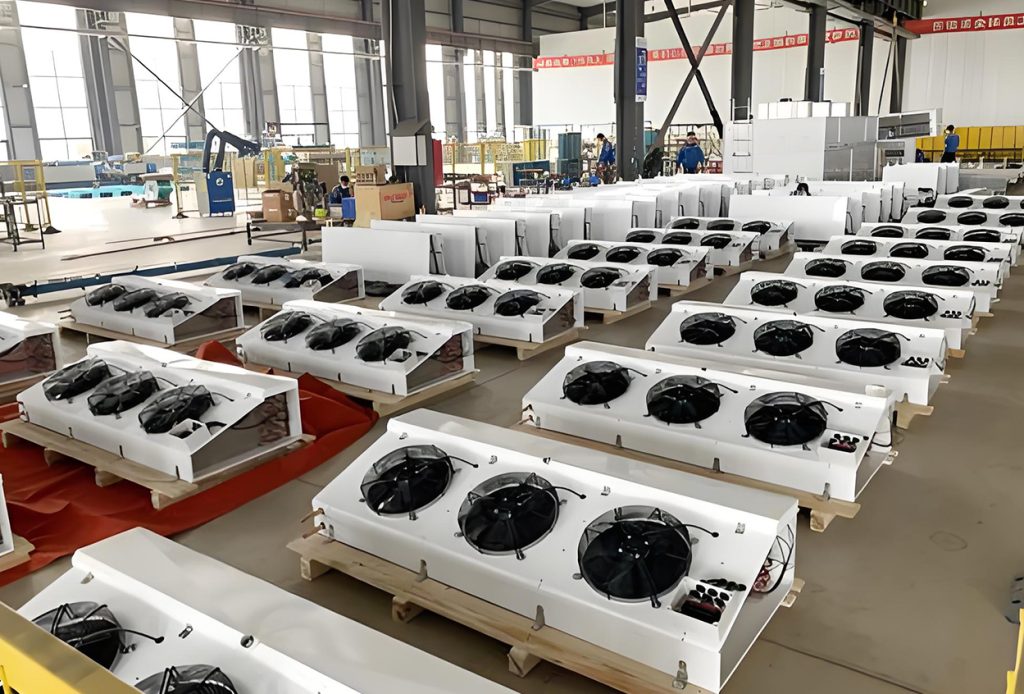
B. Analysis of the seven core technical reasons for intermittent startup
(1) Thermodynamic Principles: Avoiding Excessive Cooling Loss
The core conflict in cold storage operation lies in balancing cooling capacity with energy input. Continuously running exhaust fans can lead to three major problems:
- Increased cooling loss: Hot air from outside continuously infiltrates through the exhaust duct, requiring the compressor to consume an additional 15%-20% of its energy to compensate for cooling loss.
- Accelerated frost formation: Continuous ventilation increases humidity on the evaporator surface, causing frost thickness to increase by 0.3-0.5mm per hour, impacting heat exchange efficiency.
- Temperature fluctuations within the warehouse: Airflow disturbances can cause temperature uniformity deviations exceeding ±1°C, exceeding storage requirements for most goods.
Case: Tests on a 200-square-meter freezer showed that when the exhaust fan was running continuously, daily power consumption increased by 48 kWh compared to intermittent operation, equivalent to an additional monthly electricity bill of approximately $172.
(2) Temperature Control Logic: Precision Adjustment Based on the PID Algorithm
Modern cold storage systems commonly use the PID (Proportional-Integral-Derivative) control algorithm. The exhaust fan's start and stop are determined by the temperature (or humidity) deviation and its rate of change:
- Proportional: When the temperature exceeds the set point by 0.3°C, the exhaust fan starts at 50% power.
- Integral: If the temperature deviation persists for 2 minutes, the power is gradually increased to 100%.
- Derivative: If the temperature decreases by more than 0.5°C/min, the fan speed is reduced in advance.
This dynamic adjustment mechanism avoids frequent starting and stopping of the exhaust fan (e.g., starting it every 10 minutes and running it for 5 minutes each time), ensuring control accuracy (±0.5°C) and extending the life of the equipment.
(3) Combined control of humidity and gas composition
For fruit and vegetable cold storage, the start and stop of the exhaust fan are also controlled by humidity sensors and gas sensors:
- When humidity exceeds 90%, the exhaust fan activates in conjunction with the dehumidifier until the humidity drops below 85%.
- When CO₂ concentration exceeds 1500ppm or ethylene concentration exceeds 0.1ppm, the exhaust fan activates for 15-30 minutes to replace the air.
Data: A controlled atmosphere cold storage extends the storage period of grapes from 90 days to 150 days and reduces the rot rate by 12% through humidity-gas composite control.
(4) Linkage control of defrost cycle
The intermittent start-up of the freezer exhaust fan is often closely related to the defrosting process:
- Before defrosting: Run the exhaust fan for 3-5 minutes to reduce humidity and minimize condensation during defrosting.
- During defrosting: Stop the exhaust fan to prevent hot air from affecting defrosting efficiency (defrosting time is typically 10-15 minutes).
- After defrosting: Run the exhaust fan at 100% power for 20-30 minutes to quickly remove moisture generated by defrosting and prevent secondary frost on the evaporator.
This linkage mechanism makes the exhaust fan exhibit obvious intermittent characteristics during the defrost cycle.
(5) Equipment protection: reducing mechanical wear and electrical loss
Continuous operation will cause irreversible damage to the exhaust fan:
- Bearing wear: Continuous operation raises bearing temperatures above 60°C, accelerating grease aging and shortening lifespan by over 50%.
- Motor overheating: When an asynchronous motor operates continuously at full load, its lifespan is halved for every 10°C increase in winding temperature.
- Capacitor loss: The starting capacitor's capacitance decreases by 8%-10% annually under continuous operation, leading to starting difficulties.
Specification requirements: According to the "Cold Storage Design Code" (GB50072-2021), the continuous operation time of the exhaust fan should not exceed 2 hours, and the interval time should not be less than 30 minutes.
(6) Energy saving and consumption reduction: the inevitable choice for economic benefits
Intermittent operation brings significant energy saving effects. Take a cold storage with 10 0.75kW exhaust fans as an example:
- Continuous operation: 24-hour power consumption = 10 × 0.75 × 24 = 180 kWh
- Intermittent operation (1:1 start-stop ratio): 24-hour power consumption = 10 × 0.75 × 12 = 90 kWh
- Annual energy savings: (180 - 90) × 365 = 32,850 kWh
(7) Environmental adaptability: coping with external climate fluctuations
Changes in the external environment will affect the exhaust fan's start and stop strategy:
- During high summer temperatures: The exhaust fan activation threshold is lowered by 0.5°C, and the operating time increases by 15%-20%.
- During low winter temperatures: The activation threshold is increased by 0.5°C, and the operating time decreases by 10%-15%.
- During high humidity during the rainy season: The humidity trigger threshold is lowered from 85% to 80% to prevent condensation in the storage unit.
This adaptive adjustment ensures that the cold storage can maintain optimal operation under different climatic conditions.
C. Intermittent Startup Control Technology and Typical Fault Analysis
(1) Hardware composition of exhaust fan control system
Modern cold storage exhaust fan control is based on PLC (Programmable Logic Controller) or DDC (Direct Digital Controller). The core hardware includes:
- Sensor layer: Temperature sensor (accuracy ±0.2°C), humidity sensor (accuracy ±3% RH), gas sensor (CO₂, ethylene)
- Controller layer: PLC host (scan cycle <10ms), expansion modules (AI/AO/DI/DO)
- Actuator layer: AC contactor (with surge protection), frequency converter (0-100% stepless speed regulation)
(2) Common control logic programming examples
The following are the key points of the PLC control ladder logic diagram for a cold storage exhaust fan:
- Temperature > Setpoint + 0.3°C → Start exhaust fan #1
- Temperature > Setpoint + 0.5°C → Start exhaust fan #2
- Humidity > 90% RH → Force all exhaust fans to start
- Every 2 hours of operation, force a 30-minute shutdown for equipment rest
(3) Five major fault scenarios of intermittent startup abnormalities
| Fault phenomenon | Possible causes | Solution |
| The exhaust fan does not start | Sensor failure/controller program error | Calibrate sensor / re-download program |
| Frequent start and stop (less than 5 minutes) | The temperature control threshold is set too low/the sensor accuracy is insufficient | Increase the temperature difference threshold / replace with a high-precision sensor |
| Stop immediately after startup | Motor overload/contactor failure | Check motor load / replace contactor |
| Intermittent startup complete failure | Power supply voltage fluctuation/PLC module damage | Installing the voltage regulator / Replacing the module |
| Running time is too long (>4 hours) | Thermostat parameter drift / cold storage insulation damage | Recalibrate thermostat/service insulation |
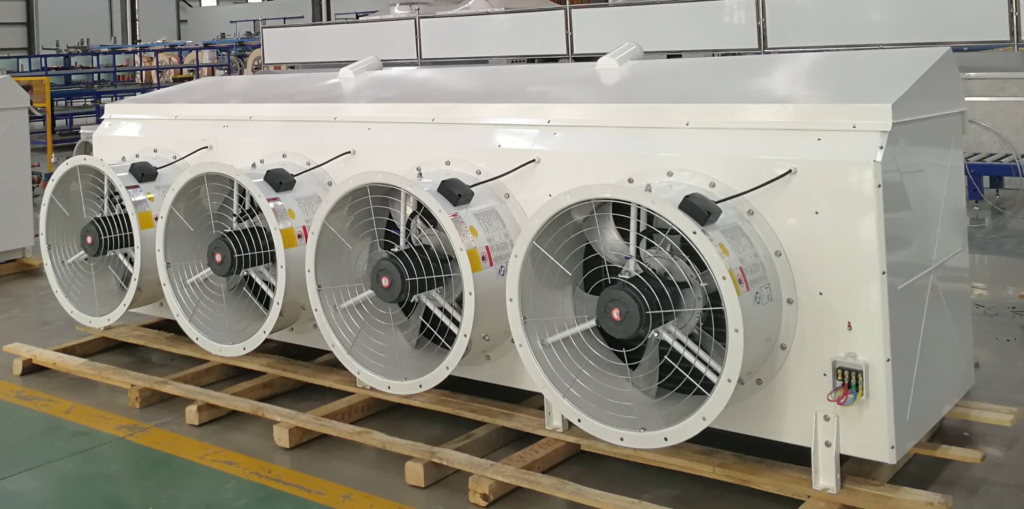
- Table: Diagnosis and troubleshooting of intermittent exhaust fan startup faults
D. Practical Path to Optimizing Intermittent Startup Strategy
(1) Intelligent control upgrade: Introducing AI prediction algorithms
Traditional PID control is difficult to handle nonlinear loads (such as frequent door openings and goods entering and leaving the warehouse). You can use:
- Machine learning model: Based on historical operating data (temperature, humidity, door opening times, etc.), it predicts load changes over the next two hours and proactively adjusts exhaust fan operation strategies.
- Fuzzy control: Classifies temperature deviation and deviation change rate into "high, medium, and low" fuzzy sets, enabling more flexible start and stop rules.
- IoT platform: Monitors exhaust fan operating status via the cloud and automatically optimizes control parameters.
Results: After upgrading to AI control in a logistics cold storage facility, exhaust fan energy consumption decreased by 18%, and the temperature fluctuation range within the facility was reduced from ±1°C to ±0.5°C.
(2) Hardware transformation: variable frequency speed regulation and energy-saving motor application
- Inverter Drive Retrofit:
Convert fixed-speed exhaust fans to variable-frequency drives, dynamically adjusting speed based on actual load:- When load is low (e.g., at night): operate at 30-50% speed
When load is high (e.g., during frequent door openings during the day): operate at 80-100% speed
- When load is low (e.g., at night): operate at 30-50% speed
- High-efficiency Motor Replacement: Replace the Y-series motor with a YE4 ultra-high-efficiency motor, improving efficiency by 5-8%
- Smart Capacitor Compensation: Install smart capacitors in the exhaust fan circuit, improving power factor from 0.75 to over 0.95.
(3) Preventive maintenance: Extending the life of equipment during intermittent operation
- Monthly Maintenance: Clean fan blades (energy consumption increases by 7% for every 1mm increase in dust accumulation), check bearing lubrication.
- Quarterly Maintenance: Calibrate sensors (temperature sensors drift approximately ±0.5°C per year), test contactor resistance.
- Annual Maintenance: Replace motor bearings, test insulation resistance (should be >2MΩ), and optimize PLC program parameters.
(4) Differentiation strategy: Customizing operation modes based on cargo characteristics
- Fruit and vegetable cold storage: Add CO₂ and ethylene sensors, implement "respiration intensity-gas concentration" linkage control, and increase exhaust fan activation frequency during peak cargo respiration periods (e.g., within three days of storage).
- Meat cold storage: Focus on temperature stability, deeply link exhaust fans with the defrost system, and extend the run time to 40 minutes after defrosting.
- Pharmaceutical cold storage: Implement a dual-sensor redundancy design (with cross-validation between active and standby sensors) to prevent exhaust fan malfunctions due to sensor failure.
E. Future development trends: from intermittent startup to adaptive intelligent operation
(1) Application of digital twin technology
By building a digital twin of the cold storage, the effects of different exhaust fan operation strategies are simulated in virtual space:
- Predict optimal start-stop cycles for different seasons and cargo storage scenarios.
- Identify potential issues (such as dead zones in certain areas) in advance and optimize exhaust fan layout.
- Implement "predictive maintenance" with automatic maintenance reminders before equipment failures occur.
(2) Coordinated operation of renewable energy
Combining renewable energy sources such as solar energy and wind energy to achieve "green intermittent operation" of exhaust fans:
- During the day, when solar power is sufficient, the exhaust fan will run longer.
- At night, when grid electricity prices are low, the stored cooling capacity will be reduced, reducing exhaust fan operation.
- When renewable energy is insufficient, the system will automatically switch to grid power.
(3) Full life cycle energy efficiency optimization
From equipment selection and control strategies to maintenance management, we build a full-chain energy efficiency optimization system:
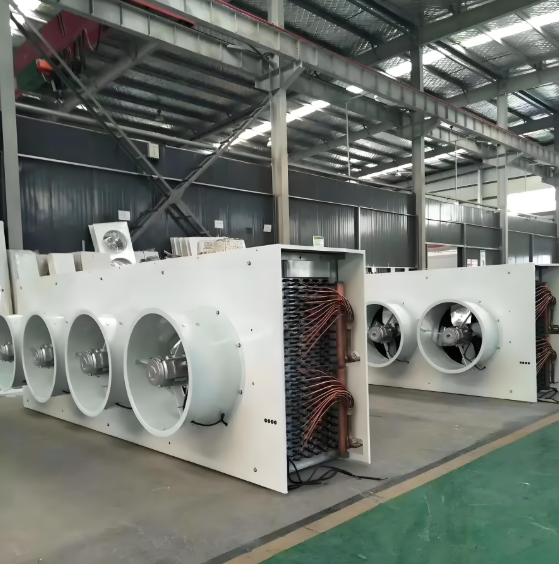
- Selection Phase: Use Class I exhaust fans (15% energy savings compared to Class II).
- Design Phase: Optimize duct design to reduce air flow resistance (for every 10 Pa reduction in resistance, energy consumption decreases by 3%).
- Operation Phase: Continuously iterate control strategies through big data analysis.
Conclusion
The intermittent activation of cold storage exhaust fans is more than simply a way to save electricity; it's the result of system optimization that integrates multiple disciplines, including thermodynamics, automatic control, materials science, and energy-saving technologies. This operating mode achieves an optimal balance between equipment lifespan, energy consumption, and maintenance costs while ensuring a stable storage environment. With the advancement of intelligent and digital technologies, the control of cold storage exhaust fans will become more precise and adaptive in the future, providing solid support for the high-quality development of cold chain logistics. For cold storage operators, a deep understanding of this underlying logic can not only optimize energy costs but also improve overall operational efficiency, giving them an advantage in the fiercely competitive market.
Welcome to inquire about products related to cold storage, refrigeration unit and panels.
You also can check our Tiktok, Youtube, Instagram channel for more video show.




